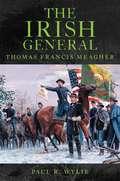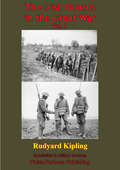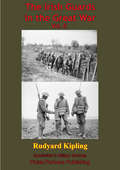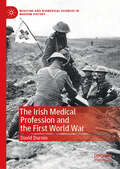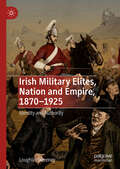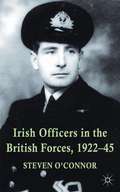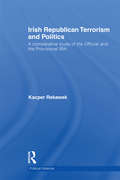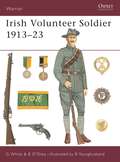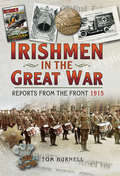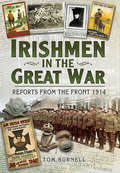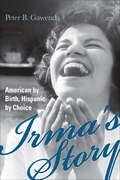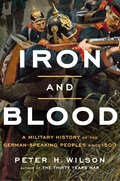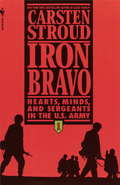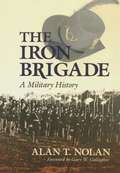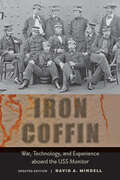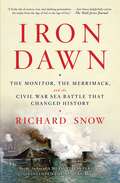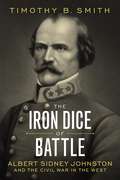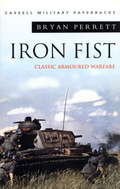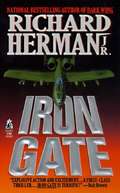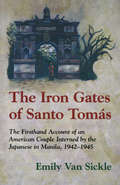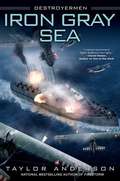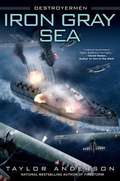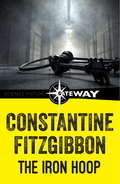- Table View
- List View
The Irish General: Thomas Francis Meagher
by Paul R. WylieIrish patriot, Civil War general, frontier governor--Thomas Francis Meagher played key roles in three major historical arenas. Today he is hailed as a hero by some, condemned as a drunkard by others. Paul R. Wylie now offers a definitive biography of this nineteenth-century figure who has long remained an enigma. The Irish General first recalls Meagher's life from his boyhood and leadership of Young Ireland in the revolution of 1848, to his exile in Tasmania and escape to New York, where he found fame as an orator and as editor of the Irish News. He served in the Civil War--viewing the Union Army as training for a future Irish revolutionary force--and rose to the rank of brigadier general leading the famous Irish Brigade. Wylie traces Meagher's military career in detail through the Seven Days battles, Antietam, Fredericksburg, and Chancellorsville. Wylie then recounts Meagher's final years as acting governor of Montana Territory, sorting historical truth from false claims made against him regarding the militia he formed to combat attacking American Indians, and plumbing the mystery surrounding his death. Even as Meagher is lauded in most Irish histories, his statue in front of Montana's capitol is viewed by some with contempt. The Irish General brings this multi-talented but seriously flawed individual to life, offering a balanced picture of the man and a captivating reading experience.
The Irish Guards In The Great War – Vol. I. [Illustrated Edition]
by Rudyard KiplingA Fantastic Regimental History of an Illustrious regiment, awarded two coveted stars by the renowned military historian and Times War Correspondent Cyril Falls:"One could be assured that when Mr Kipling turned his hand to a regimental history the result would be very different to the ordinary. The particular invention wherewith he has enriched this book is a sort of chorus--the comment of the private soldier upon the events narrated, which is witty and effective. Mr Kipling has also brought to bear his magic upon that most matter-of-fact of records, the battalion war diary, and has made it live. *** he has composed a noble tribute to the great regiment in the ranks of which he lost his son."-- Cyril Falls, War Books, London 1930.Illustrated with sumptuously detailed maps.
The Irish Guards In The Great War – Vol. II. [Illustrated Edition]
by Rudyard KiplingA Fantastic Regimental History of an Illustrious regiment, awarded two coveted stars by the renowned military historian and Times War Correspondent Cyril Falls:"One could be assured that when Mr Kipling turned his hand to a regimental history the result would be very different to the ordinary. The particular invention wherewith he has enriched this book is a sort of chorus--the comment of the private soldier upon the events narrated, which is witty and effective. Mr Kipling has also brought to bear his magic upon that most matter-of-fact of records, the battalion war diary, and has made it live. *** he has composed a noble tribute to the great regiment in the ranks of which he lost his son."-- Cyril Falls, War Books, London 1930.Illustrated with sumptuously detailed maps.
The Irish Medical Profession and the First World War (Medicine and Biomedical Sciences in Modern History)
by David DurninThis book examines the role of the Irish medical profession in the First World War. It assesses the extent of its involvement in the conflict while also interrogating the effect of global war on the development of Ireland’s domestic medical infrastructure, especially its hospital network. The study explores the factors that encouraged Ireland’s medical personnel to join the British Army medical services and uncovers how Irish hospital governors, in the face of increasing staff shortages and economic inflation, ensured that Ireland’s voluntary hospital network survived the war. It also considers how Ireland’s wartime doctors reintegrated into an Irish society that had experienced a profound shift in political opinion towards their involvement in the conflict and subsequently became embroiled in its own Civil War. In doing so, this book provides the first comprehensive study of the effect of the First World War on the medical profession in Ireland.
Irish Military Elites, Nation and Empire, 1870–1925: Identity and Authority
by Loughlin SweeneyThis book is a social history of Irish officers in the British army in the final half-century of Crown rule in Ireland. Drawing on the accounts of hundreds of officers, it charts the role of military elites in Irish society, and the building tensions between their dual identities as imperial officers and Irishmen, through land agitation, the home rule struggle, the First World War, the War of Independence, and the partition of Ireland. What emerges is an account of the deeply interwoven connections between Ireland and the British army, casting officers as social elites who played a pivotal role in Irish society, and examining the curious continuities of this connection even when officers’ moral authority was shattered by war, revolution, independence, and a divided nation.
Irish Officers in the British Forces, 1922–45
by Steven O’ConnorIrish Officers in the British forces, 1922-45 looks at the reasons why young Irish people took the king's commission, including the family tradition, the school influence and the employment motive. It explores their subsequent experiences in the forces and the responses in independent Ireland to the continuation of this British military connection.
Irish Republican Terrorism and Politics: A Comparative Study of the Official and the Provisional IRA (Political Violence)
by Kacper RekawekThis book examines the post-ceasefire evolutions and histories of the main Irish republican terrorist factions, and the interconnected character of politics and militarism within them. Offering the first comparative study of the two leading Irish republican terrorist movements the Official IRA and the Provisional IRA (PIRA), this book presents the lesser-known Officials’ political-military evolution and analyses whether they could have been role models for the Provisionals. Not only does it compare the terrorism and the politics of the Officials and Provisionals in the aftermath of their seminal ceasefires of 1972 and 1994, it also presents the Irish republican history in a new light and brings to the fore the understudied and disregarded Officials who called their seminal ceasefire twenty-two years before their rivals in 1972. In doing this, the work discusses whether the PIRA might have learned lessons from the bitter and ultimately unsuccessful experience of the Officials. This book goes beyond traditional interpretations of the rivalry and competition between the two factions with the Officials usually seen as non-violent but unsuccessful and the Provisionals less politically inclined and mostly concerned with their armed struggle. Simultaneously, it dispels the myth of the alleged Provisional republican copying of their Official republican counterparts who seemed ready for a political compromise in Northern Ireland more than twenty years before the Good Friday Agreement of 1998. Finally, it comprehensively compares the Officials and the Provisionals within the identified key areas and assesses the two factions’ differences and similarities. . This book will be of much interest to students of Irish politics, terrorism studies, security studies and politics in general.
Irish Volunteer Soldier 1913-23
by Gerry White Bill YounghusbandThe political situation in Ireland at the beginning of the 20th century was characterised by crisis and change. Armed rebellion against the British Crown, the prosecution of the Anglo-Irish War, the emergence of the Irish Free State, and the eruption of the Civil War over the treaty with Great Britain ensured that the birth of the modern Irish nation was bloody and difficult. This book details the life of an average Volunteer, and includes the experiences of internment, the lack of established medical facilities for wounded, life on the run, discipline, and typical duties.
Irishmen in the Great War: Reports From The Front 1915
by Tom BurnellIn a quest to to discover the forgotten Irishmen in twenty-seven Irish newspapers, many of which are now obsolete, the author uncovered unbelievable and forgotten newspaper articles, cast aside since the 1920s until now. Following the success of the first book in the series covering 1914, Irishmen in the Great War: Reports from the Front 1915 is a labour of love from author Tom Burnell, containing over 150 hand-picked news stories taken from a selection of twenty-seven Irish newspapers throughout the course of the year. These rare and untapped stories, many of which have not seen the light of day since the 1920s, give a unique insight into life on the front line and on the home front during the First World War.These are the accounts of local men at the front, letters sent home from soldiers in the trenches at Flanders, graphic narratives from allied gun turrets, Irish nuns at Ypres, Irish POWs held in Germany, troops coming under fire on Christmas morning and many more.We are presented with articles explaining the logistical side of supporting the army, from how the men at the front were fed to combating ailments brought about by living in the trenches. A letter from a surgeon of the King's Country Infirmary explains the graphic experiences of everyday life on the front line and the newspapers present feature articles on the use of torpedos, hand grenades, warplanes and more.Translated German letters pay tribute to the courage, stamina and shooting skill shown by the British and letters from British troops remark on the deathly accuracy of the German snipers. We also hear of a Kilkennyman who survived the sinking of the Lusitania and how the attack strengthened the resolve of Irish soldiers on the front.We see letters from lieutenants in the Leinsters, privates in the Munsters at Egypt, the Connaughts at Turkey, a fifteen-year-old soldier of the 18th London Irish Rifles, a Kilmoganny soldier writing to the Kilkenny People during a lull in the fighting, letters explaining how the 2nd Royal Irish Rifles fought at Neuve Chapelle and an officer's harrowing description of a gas attack at Hill 60.Following the success of the first book in the series covering 1914, Irishmen in the Great War: Reports from the Front 1915 is a labour of love from author Tom Burnell, containing over 150 hand-picked news stories taken from a selection of twenty-seven Irish newspapers throughout the course of the year. These rare and untapped stories, many of which have not seen the light of day since the 1920s, give a unique insight into life on the front line and on the home front during the First World War.
Irishmen in the Great War: Reports from the Front 1914
by Tom BurnellTwenty-seven Irish newspapers for the period covering the Great War have been trawled through to deliver the amazing stories of those years which changed the world for ever. These are the accounts of local men at the front; of torpedoed ships; drunken wives; final letters and requests from the trenches. Also eye-witness accounts of the slaughter as it was happening; battle reports from officers serving in Irish regiments; quirky snippets; chaplains' sympathetic letters; P.o.W reports of conditions and war poetry. Here are the tales of the Leinster's, Munster's, Connaught's and Dublin Fusiliers serving in the Ulster Division, 10th and 16th Irish Divisions. We read of medical breakthroughs, paranormal occurrences and miraculous escapes from death. After the Irish Rebellion of April, 1916, these type of articles and casualty lists dwindled to very few as Irish hearts became divided.As featured on Tipp FM and in the Tipperary Star and Dungarvan Observer.
Irma's Story: American by Birth, Hispanic by Choice (Irma's Story Ser.)
by Peter B. Gawenda“The compelling true story of the impassioned love shared between a south Texas woman of Hispanic descent and a German military officer.” —Yvonne Freeman, PhD, professor, Department of Language, Literacy, and Intercultural Studies at the University of Texas at BrownsvilleAfter World War II, Peter, a handsome German pilot, met Irma, a beautiful Texan woman of Hispanic descent. It was love at first sight. Their meeting had been prophesized—for Irma by her grandmother and for Peter by a palm reader—and together the couple would create an extraordinary life. Irma’s Story: American by Birth, Hispanic by Choice chronicles Irma’s life and the experiences of the “Texan Gawendas” during their tenure in the German military in Europe and the United States. Though Irma, accepted as an American while in Europe, faced discrimination in her home country and contended with the challenges of being a military wife, Peter’s love and companionship remained constant.In his second book, Peter B. Gawenda, author of The Children’s War, offers readers an insider’s view of the joys that the marriage of two people—from two completely different worlds—can bring. Presenting the dynamics of racial issues against the backdrop of military life, the captivating story of Irma Lozano de Gawenda depicts a fearless, fiercely loyal woman willing to do anything for her family.Written with a passion that has spanned five decades, Irma’s Story celebrates the strength of a once-in-a-lifetime love.“He thrills [readers] again, turning to his narrative gifts and rich trove of memories to tell another story with universal appeal—the power of enduring love.” —Robert Becker, veteran journalist and former international wire news editor, Houston Chronicle
Iron and Blood: A Military History of the German-Speaking Peoples since 1500
by Peter H. WilsonFrom the author of the acclaimed The Thirty Years War and Heart of Europe, a masterful, landmark reappraisal of German military history, and of the preconceptions about German militarism since before the rise of Prussia and the world wars.German military history is typically viewed as an inexorable march to the rise of Prussia and the two world wars, the road paved by militarism and the result a specifically German way of war. Peter Wilson challenges this narrative. Looking beyond Prussia to German-speaking Europe across the last five centuries, Wilson finds little unique or preordained in German militarism or warfighting.Iron and Blood takes as its starting point the consolidation of the Holy Roman Empire, which created new mechanisms for raising troops but also for resolving disputes diplomatically. Both the empire and the Swiss Confederation were largely defensive in orientation, while German participation in foreign wars was most often in partnership with allies. The primary aggressor in Central Europe was not Prussia but the Austrian Habsburg monarchy, yet Austria’s strength owed much to its ability to secure allies. Prussia, meanwhile, invested in militarization but maintained a part-time army well into the nineteenth century. Alongside Switzerland, which relied on traditional militia, both states exemplify the longstanding civilian element within German military power.Only after Prussia’s unexpected victory over France in 1871 did Germans and outsiders come to believe in a German gift for warfare—a special capacity for high-speed, high-intensity combat that could overcome numerical disadvantage. It took two world wars to expose the fallacy of German military genius. Yet even today, Wilson argues, Germany’s strategic position is misunderstood. The country now seen as a bastion of peace spends heavily on defense in comparison to its peers and is deeply invested in less kinetic contemporary forms of coercive power.
Iron Bravo
by Carsten StroudFirst Sergeant Dee Crane, a Vietnam Eleven Bravo, recounts his experiences alongside his men, his duties at the National Training Center in the Mojave Desert, and his most recent encounters in the Persian Gulf.
The Iron Brigade: A Military History
by Alan T. NolanThis is the story of the most famous unit in the Union Army, the only all-Western brigade in the Eastern armies of the Union―made up of troops from Indiana, Wisconsin, and Michigan.
Iron Coffin: War, Technology, and Experience aboard the USS Monitor (Johns Hopkins Introductory Studies in the History of Technology)
by David A. MindellThe USS Monitor famously battled the CSS Virginia (the armored and refitted USS Merrimack) at Hampton Roads in March 1862. This updated edition of David A. Mindell's classic account of the ironclad warships and the human dimension of modern warfare commemorates the 150th anniversary of this historic encounter.Mindell explores how mariners—fighting "blindly," below the waterline—lived in and coped with the metal monster they called the "iron coffin." He investigates how the ironclad technology, new to war in the nineteenth century, changed not only the tools but also the experience of combat and anticipated today’s world of mechanized, pushbutton warfare. The writings of William Frederick Keeler, the ship’s paymaster, inform much of this book, as do the experiences of everyman sailor George Geer, who held Keeler in some contempt. Mindell uses their compelling stories, and those of other shipmates, to recreate the thrills and dangers of living and fighting aboard this superweapon. Recently, pieces of the Monitor wreck have been raised from their watery grave, and with them, information about the ship continues to be discovered. A new epilogue describes the recovery of the Monitor turret and its display at the USS Monitor Museum in Newport News, Virginia.This sensitive and enthralling history of the USS Monitor ensures that this fateful ship, and the men who served on it, will be remembered for generations to come.
Iron Coffins: A Personal Account of the German U-Boat Battles of World War II
by Herbert A. WernerFrom the Foreword by Captain Edward L. Beach, U.S. Navy (Ret.) "Madness!" cries Werner, and it was madness. But there were heroes, too, who deserve admiration even though their cause was wrong.... No one can fault the warrior who believes in his country so strongly that he dies for it.... Because their leaders told them so, they believed that if they fought desperately, they might save their country from the disaster plainly grinding in from every side. They expected death, and most of them found it, but they fought hard all the same, and they carpeted the ocean floor with their bodies.
Iron Dawn: The Monitor, the Merrimack, and the Civil War Sea Battle that Changed History
by Richard SnowFrom acclaimed popular historian Richard Snow, who "writes with verve and a keen eye" (The New York Times Book Review), the thrilling story of the naval battle that not only changed the Civil War but the future of all sea power.No single sea battle has had more far-reaching consequences than the one fought in the harbor at Hampton Roads, Virginia, in March 1862. The Confederacy, with no fleet of its own, built an iron fort containing ten heavy guns on the hull of a captured Union frigate named the Merrimack. The North got word of the project when it was already well along, and, in desperation, commissioned an eccentric inventor named John Ericsson to build the Monitor, an entirely revolutionary iron warship--at the time, the single most complicated machine ever made. Abraham Lincoln himself was closely involved with the ship's design. Rushed through to completion in just 100 days, it mounted only two guns, but they were housed in a shot-proof revolving turret. The ship hurried south from Brooklyn (and nearly sank twice on the voyage), only to arrive to find the Merrimack had arrived blazing that morning, destroyed half the Union fleet, and would be back to finish the job the next day. When she returned, the Monitor was there. She fought the Merrimack to a standstill, and saved the Union cause. As soon as word of the battle spread, Great Britain--the foremost sea power of the day--ceased work on all wooden ships. A thousand-year-old tradition ended, and the path to the naval future opened. Richly illustrated with photos, maps, and engravings, Iron Dawn is the irresistible story of these incredible, intimidating war machines. Historian Richard Snow brings to vivid life the tensions of the time, explaining how wooden and ironclad ships worked, maneuvered, battled, and sank. This full account of the Merrimack and Monitor has never been told in such immediate, compelling detail.
The Iron Dice of Battle: Albert Sidney Johnston and the Civil War in the West
by Timothy B. SmithKilled in action at the bloody Battle of Shiloh, Confederate general Albert Sidney Johnston stands as the highest-ranking American military officer to die in combat. His unexpected demise had cascading negative consequences for the South’s war effort, as his absence created a void in adequate leadership in the years that followed. In The Iron Dice of Battle, noted Civil War historian Timothy B. Smith reexamines Johnston’s life and death, offering remarkable insights into this often-contradictory figure.As a commander, Johnston frequently faced larger and better-armed Union forces, dramatically shaping his battlefield decisions and convincing him that victory could only be attained by taking strategic risks while fighting. The final wager came while leading his army at Shiloh in April 1862. During a desperate gambit to turn the tide of battle, Johnston charged to the front of the Confederate line to direct his troops and fell mortally wounded after sustaining enemy fire.The first work to survey the general’s career in detail in nearly sixty years, The Iron Dice of Battle builds on recent scholarship to provide a new and incisive assessment of Johnston’s life, his Confederate command, and the effect his death had on the course of the Civil War in the West.
Iron Fist: Classic Armoured Warfare Case Studies (Cassell Military Classics Ser.)
by Bryan PerrettThe greatest tank battles of history from the Great War to the Gulf, examined by one of Britain's bestselling military writers.The story of the evolution of armoured warfare in the 20th century, which has seen tanks and other armoured vehicles develop from lumbering, primitive and vulnerable Goliaths to the immensely potent and manoeuvrable agents of lightning battlefield success. This is a collection of the greatest moments of armoured history from the conception of the tank as a means to break the stalemate of the Western Front to Blitzkreig, the great tank battles of the Second World War and the 'mother of all battles' in the Gulf in 1991.
Iron Fist: Classic Armoured Warfare (W&N Military)
by Bryan PerrettThe greatest tank battles of history from the Great War to the Gulf, examined by one of Britain's bestselling military writers.The story of the evolution of armoured warfare in the 20th century, which has seen tanks and other armoured vehicles develop from lumbering, primitive and vulnerable Goliaths to the immensely potent and manoeuvrable agents of lightning battlefield success. This is a collection of the greatest moments of armoured history from the conception of the tank as a means to break the stalemate of the Western Front to Blitzkreig, the great tank battles of the Second World War and the 'mother of all battles' in the Gulf in 1991.
Iron Gate
by Richard Herman Jr.Air Force legend Colonel Matt Pontowski is a seasoned leader, and a pro at dodging both bureaucratic bull and enemy fire on the job. When his composite wing of A-10 Wart Hogs and C-130s, the 442nd, is sent on a UN peacekeeping mission in South Africa, he finds no ordinary war, but a country on the brink of disaster, divided by an enemy of Unimaginable evil. From within a massive granite fortress called Iron Gate, Hans Beckmann's directs the Afrikaner Resistance Movement, and envisions a future spawned from his supremacist dogma. More than an isolated madman, this violent and charismatic leader controls the frighteningly real power of cold nuclear fusion- and now threatens international security as his Insurgents tighten their grip. After the UN mission dissolves into a fiasco, Pontowski does damage control by leading the men and women of the 442nd straight into hellfire for an all-out aerial assault on Iron Gate- where the devastating consequences of failure will reach far beyond its immovable walls.
The Iron Gates of Santo Tomas: A Firsthand Account of an American Couple Interned by the Japanese in Manila, 1942-1945
by Emily Van SickleWhen Manila fell to the Japanese in January, 1942, the Van Sickles were among the enemy aliens taken by the victors to the campus of Manila's University of Santo Tomas, where they were to remain unwilling "guests" for more than three years. This is a fascinating, detailed and insightful account of life in a civilian concentration camp as gripping and readable as any tale of adventure.
Iron Gray Sea (Destroyermen, Book #7)
by Taylor AndersonFrom The Front Flap: "Taylor Anderson and his patched-up four-stackers have steamed to the forefront of alternative history. All aboard for a cracking great read!" --E. E. Knight, Author of March in Country In Taylor Anderson's acclaimed Destroyermen series, a parallel universe adds an extraordinary layer to the drama of World War II. Now Lieutenant Commander Matthew Reddy, the crew of USS Walker, and their allies battle an ever-growing host of enemies across the globe in a desperate fight for freedom.... War has engulfed the "other" earth. With every hard-won victory and painful defeat, Matt Reddy and the allies encounter more friends--and even more diabolical enemies. At last in the arms of the woman he loves, Reddy still finds little peace. The vast sea and the scope of the conflict have trapped him too far away to help on either front, but that doesn't mean he and Walker can rest. Cutting short his "honeymoon," Reddy sails off in pursuit of Hidoiame, a rogue Japanese destroyer wreaking havoc in allied seas. Now that Walker is armed with the latest "new" technology, he hopes his battle-tested four-stacker has an even chance in a straight-up fight against the bigger ship--and he means to take her on. Elsewhere, the long-awaited invasion of Grik "Indiaa" has begun, and the Human-Lemurian Alliance is pushing back against the twisted might of the Dominion. The diplomatic waters seethe with treachery and a final, terrible plot explodes in the Empire of the New Britain Isles. Worse, the savage Grik have also mastered "new" technologies and strategies. Their fleet of monstrous ironclads--and an army two years in the making--is finally massing to strike....
Iron Gray Sea
by Taylor AndersonWar has engulfed the other earth, the parallel universe that Lt Commander Matt Reddy and the crew of the USS Walker now call home. With every hard-won victory and painful defeat, Reddy and the Allies encounter more friends--and even more diabolical enemies. Cutting short his "honeymoon," Reddy sails off in pursuit of Hidoiame, a rogue Japanese destroyer that is wreaking havoc in Allied seas. Now that Walker is armed with the "latest" technology, he hopes the four-stacker can handle a straight-up fight against the bigger ship. Elsewhere, the long-awaited invasion of Grik "Indiaa" has begun, and the Human-Lemurian Alliance is pushing back against the twisted might of the Dominion, even as political machinations threaten the Alliance from within. But the savage Grik have also mastered "new" technologies. And their fleet of monstrous ironclads and a bloodthirsty army are finally massing to strike...
The Iron Hoop
by Constantine FitzgibbonOriginally published in 1950, The Iron Hoop is a novel of the victors and the vanquished. Set in New York in a post-war occupation era, the Iron Hoop is a ruined part of the city occupied by refugees, deserters, criminals and victims.
